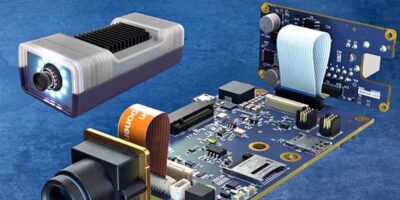To accelerate proof of concept, rapid prototyping and small series production, Vision Components has collaborated with AU-Zone and Toradex to create the Maivin i.MX 8M Plus AI vision kit.
The developer kit is based on a Toradex Verdin i.MX 8M Plus system on module (SoM) and a carrier board designed by AU-Zone which accommodates up to two VC MIPI camera modules.
NXP’s i.MX 8M Plus processor has a neural network processor unit (NPU) and an integrated image signal processor. The Verdin SoM for the kit has been extended by a variable SoM adapter and connector board from AU-Zone, which enables users to build functional models. The VC MIPI IMX327-C (colour) and VC MIPI IMX296 (monochrome) camera modules are combined with the required interfaces and I/Os for individual rapid prototyping up to small series. Additional VC camera modules are also compatible. The AU-Zone connector boards can also be custom-developed with interfaces and functionalities for individual requirements. This makes the Maivin i.MX 8M Plus AI vision kit for a range of applications, including automation and robotics, medical technology or the agricultural industry. The kit also includes a housing, including lighting.
Drivers ensure optimal image processing, says Vision Components, which enable the direct connection and support of the VC MIPI camera modules with the NXP i.MX 8M processor family. They have been integrated into Toradex’ software platform, TorizonCore, which allows access to the image signal processor (ISP) of the i.MX 8M Plus. The ISP can be used for advanced image pre-processing such as colour conversion, geometry correction, HDR and gamma correction. The software platform also includes comprehensive frameworks for an easy entry into development, over the air updates and security features.
The kit also includes AU-Zone’s DeepView machine learning toolkit is also part of the Maivin i.MX 8M Plus AI vision kit. It includes machine learning demos for object recognition, classification, and tracking that can be customised to the users own AI models and datasets using the NXP eIQ toolkit. NXP continues to add tools to the development environment, including a GUI-based interface, and the DeepViewRT engine which is optimised for the i.MX platform. The company also added that other applications, for example AU-Zone applications, can be integrated and used to develop vision systems.
Vision Components drivers for the NXP i.MX 8M processor family are also available for platforms in addition to the Toradex Verdin SoM series platforms.
The kit is scheduled to be ready for shipping in Q3 2021.







